
How to Remove a Stuck Ring: 5 Methods That Guarantee Results
When Every Second Counts: Understanding Ring Rescue
Ring rescue refers to the safe removal of a stuck ring from a swollen finger, which can prevent serious complications like tissue damage or even amputation.
Quick Ring Rescue Methods:
- Non-destructive techniques - Compression devices, ice, elevation, and lubricants
- Destructive techniques - Specialized ring cutters for when non-destructive methods fail
- Professional tools - The Ring Rescue Kit with Compression Device and Dolphin Ring Cutter
A stuck ring might seem like a minor inconvenience, but it can quickly escalate into a medical emergency. When a ring becomes too tight on a finger, it can restrict blood flow, causing pain, swelling, and even tissue death if not addressed promptly. The term ring rescue encompasses various techniques used by medical professionals, emergency responders, and even jewelry experts to safely remove rings without causing further harm to the finger or destroying the ring itself.
Traditional methods like cutting rings can be challenging, especially with modern rings made of tungsten, titanium, or cobalt. These materials are extremely difficult to cut with standard tools and often require specialized equipment. Additionally, cutting a cherished ring, like a wedding band or family heirloom, can be emotionally distressing for the patient.
That's where modern ring rescue solutions come in. The Ring Rescue Kit, which includes a Compression Device and the Dolphin Ring Cutter, offers both non-destructive and destructive options for safe ring removal. The Compression Device uses controlled air pressure to temporarily shrink finger size, allowing for ring removal without cutting in many cases.
While companies like Ring Rescue, Zayden Medical, and HexArmor offer specialized tools for this purpose, we at American Mortuary Coolers have extensive experience providing ring rescue solutions to medical facilities, fire departments, and emergency services. Our work has shown that having the right tools and techniques can make all the difference in preserving both patient safety and sentimental jewelry during emergencies.
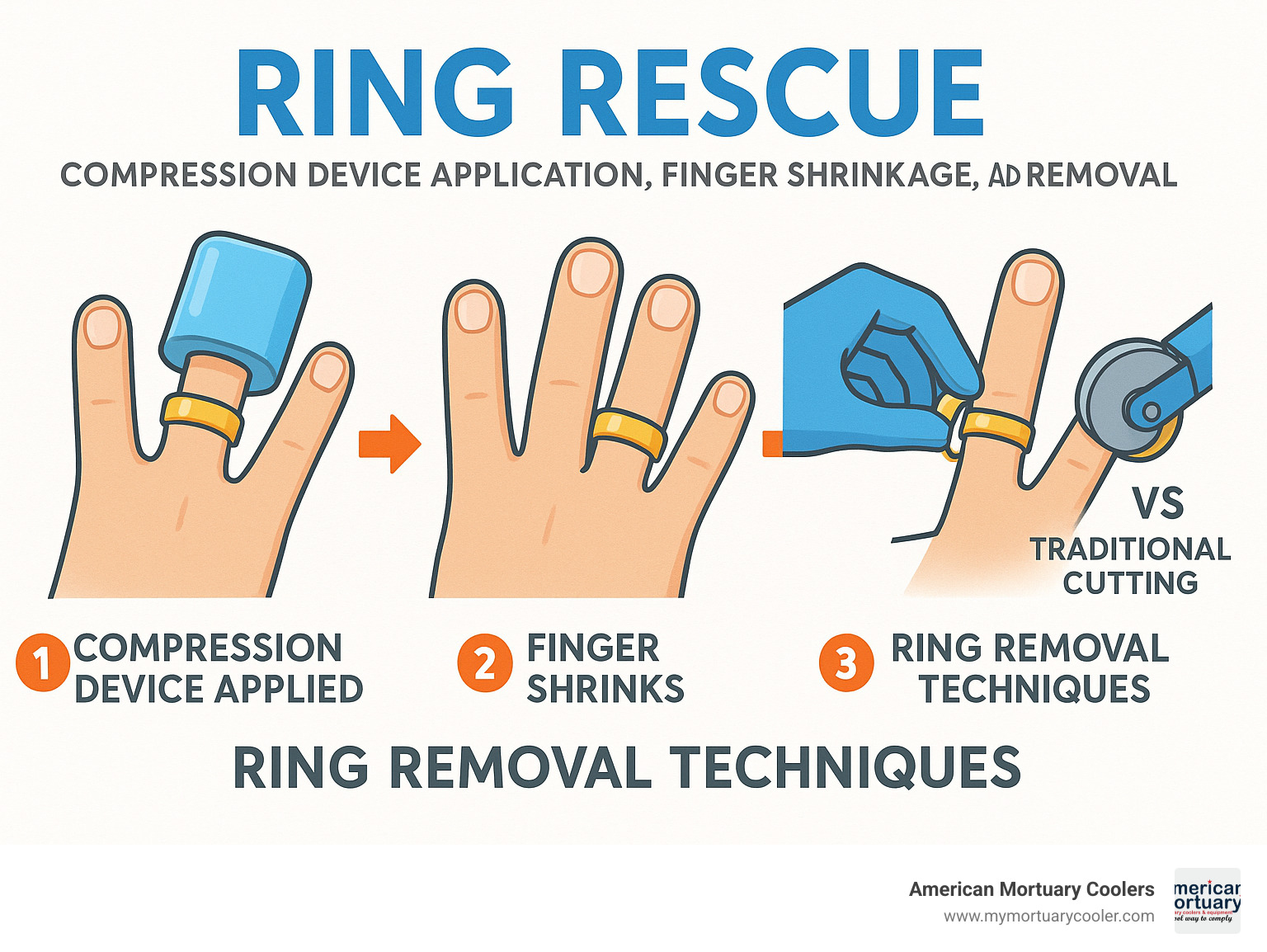
Common ring rescue vocab:
5 Warning Signs Your Ring Needs Immediate Attention
When a ring gets stuck, it's not just an inconvenience – it can quickly become a medical emergency. Through our work with emergency departments across the country, we've learned that recognizing the warning signs early can make all the difference between a simple fix and a serious complication.
Color changes in your finger are perhaps the most visible red flag. When your fingertip turns white, blue, or purple beyond where the ring sits, your body is literally sending you a color-coded warning. This discoloration signals that blood isn't flowing properly – a condition doctors call ischemia – and your tissues are literally starving for oxygen.
Has your finger started feeling numb or tingly? This isn't just your body "falling asleep" – it's your nerves responding to dangerous compression. Without quick intervention, this numbness can become permanent nerve damage.
Pain is your body's alarm system, and when it comes to a stuck ring, increasing pain means it's time to act. While some discomfort is expected with any tight ring, intense or escalating pain signals that tissues are being seriously compromised.
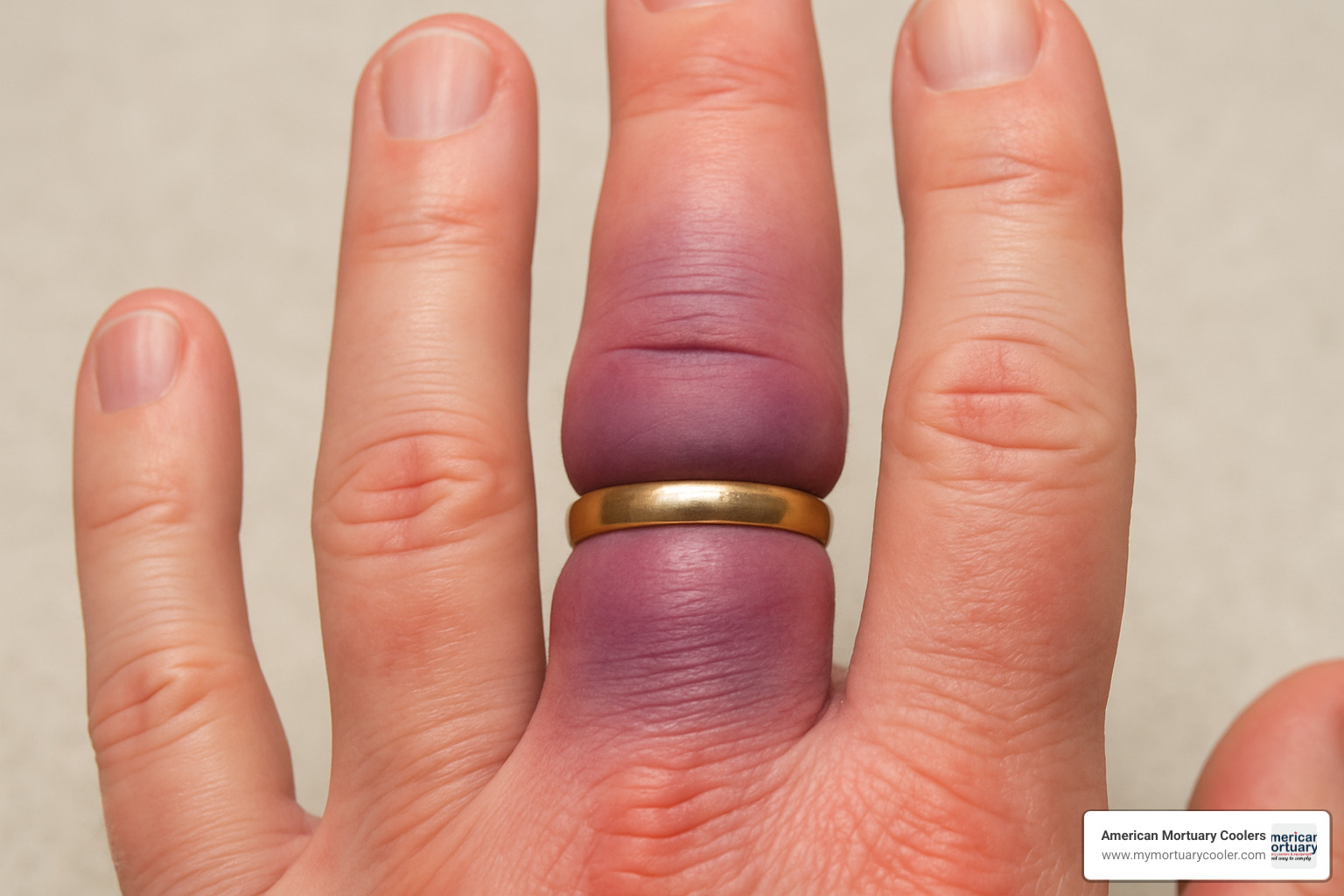
Watch for rapid swelling – it creates a dangerous cycle where the tighter the ring becomes, the more your finger swells in response. This vicious circle can quickly spiral into a serious emergency within hours.
Finally, if you can't move your finger normally, it's a sign that the swelling has progressed to affect tendons and joints. This restricted movement indicates advanced compression that needs immediate attention.
Medical professionals refer to these combined symptoms as "Ring Tourniquet Syndrome" – a condition that can lead to tissue necrosis (death) if left untreated. According to research published in the European Journal of Emergency Medicine, vascular compromise can begin within just hours of a ring becoming too tight, potentially leading to permanent damage or even amputation in severe cases.
The good news? With prompt attention and the right techniques, most stuck rings can be removed safely – protecting both your finger and your cherished jewelry.
Method 1: Home First-Aid—Ice, Elevation & Lubrication
When you first notice your ring getting tight, quick action with simple home remedies can often save you a trip to the emergency room. For mild cases where your finger isn't severely discolored or painful, these first steps can make all the difference.
Start with cold therapy—it's your first line of defense against swelling. Wrap an ice pack in a thin cloth (never apply ice directly to skin) and gently hold it against your finger for 5-10 minutes. The cold causes your blood vessels to narrow, which naturally reduces swelling. While you're icing, keep that hand raised above your heart level. This simple position uses gravity to help drain excess fluid from your finger.
Keep your hand lifted for another 5-10 minutes after icing. This simple technique works wonders for many people with mildly stuck rings. The combination of cold and elevation often creates just enough shrinkage to free the ring.
Safe Lubricants & Positions
Once you've reduced the swelling, it's time for the slippery stuff. But not just any lubricant will do—some can actually make things worse!
Choose non-hydrating lubricants like mineral oil or petroleum jelly. These create a slick barrier without being absorbed into your skin, maintaining their slipperiness when you need it most. Dish soap can also work well, creating a thin film that helps the ring slide over your knuckle.
What you want to avoid are water-based products. They might feel slippery at first, but they quickly absorb into your skin and can actually increase swelling—exactly what you don't want!
The hand-over-head posture continues to be your friend during lubrication. Keep that arm up high while you apply your lubricant of choice and attempt to twist (not just pull) the ring off. The gentle rotation helps the ring steer over knuckles and swollen areas more effectively than straight pulling.
Throughout this process, keep checking your finger's color, temperature, and sensation. If your finger gets more painful, turns blue or white, or feels numb, stop immediately and seek professional help.
Method 2: Classic Wrap Techniques—Strings, Bands & Caterpillars
When simple lubrication isn't working, compression wrapping techniques can temporarily shrink your finger's size, creating just enough space for that stubborn ring to slide off.
Two-Rubber-Band Method
Start by sliding a thin rubber band under the ring from the fingertip side. Then take a second rubber band and wrap it tightly around the finger beginning at the tip, slowly working your way toward the ring. As you reach the ring, begin unwrapping the first rubber band—this creates a gentle pulling motion that guides the ring over your compressed tissue.
Dental Floss Winding Technique
This is probably the most widely used ring rescue method in emergency departments. Grab some unwaxed dental floss and carefully slide one end under the ring, pushing it toward the fingertip. Leave a generous tail extending past your fingertip. Now, wrap the floss tightly around your finger, starting at the ring and working toward the fingertip. The wrapping compresses the swollen tissue, and when you're done, simply pull that tail end you left. The unwinding floss creates a gentle "conveyor belt" that guides the ring over your compressed finger.
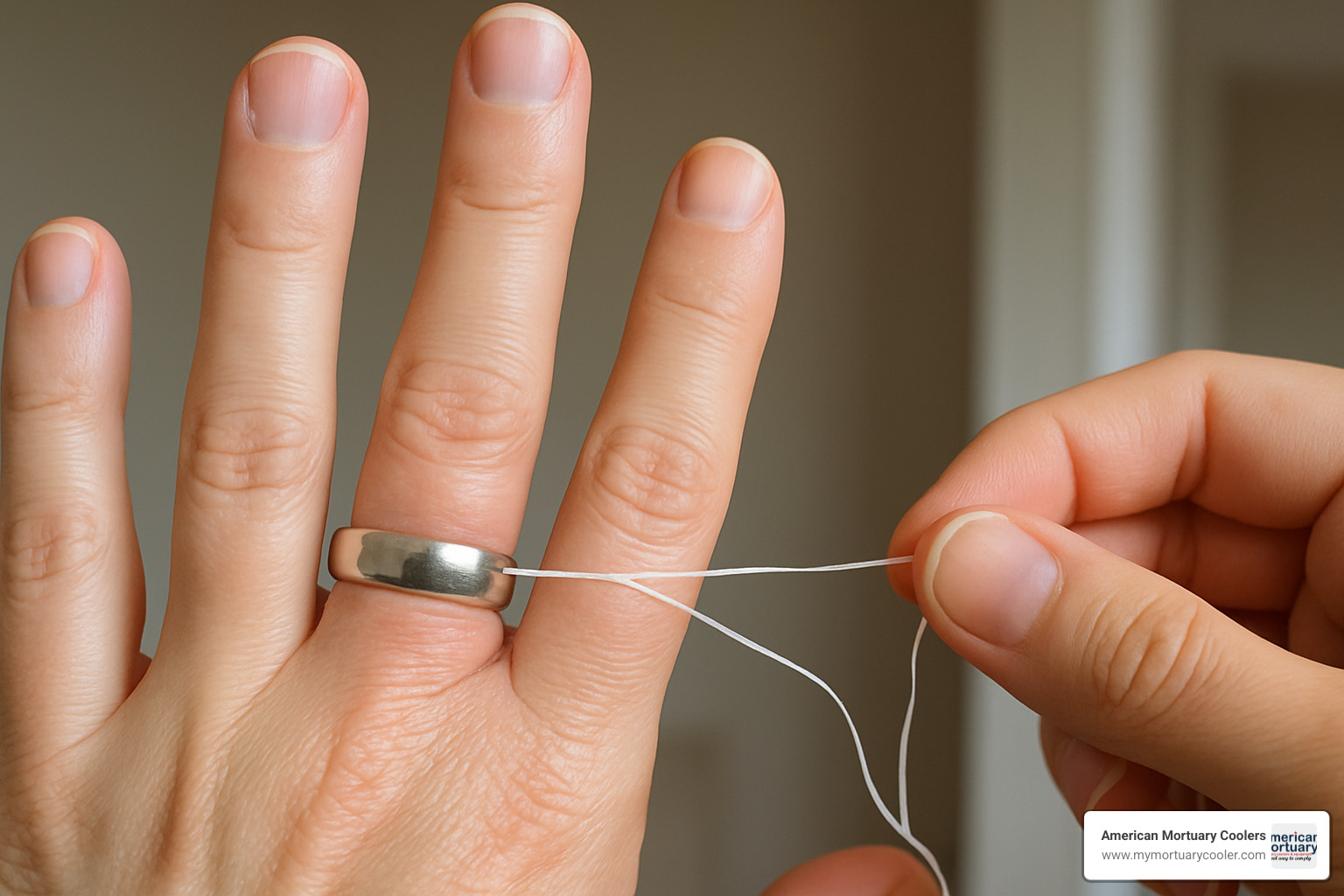
Caterpillar Technique
In medical settings, professionals often use what's called the caterpillar technique with a thin elastic material like a Penrose drain. Start with generous lubrication on your finger, then slide the elastic material under the ring. Wrap it tightly around your finger from the ring toward the fingertip. When you pull the end that was passed under the ring, it creates a fascinating "caterpillar" motion that inches the ring forward.
When to Abandon DIY Wraps
While these techniques are effective, knowing when to stop is just as important as knowing what to try:
- Stop immediately if you notice skin breakdown
- Give up after 2-3 serious attempts
- For rings made of hard-to-cut metals like tungsten or titanium, consider professional help sooner
- If your finger has been swollen for weeks or months due to chronic conditions, DIY methods are less likely to work
Companies like Ring Rescue, Zayden Medical, and even general medical suppliers like Bound Tree and Henry Schein offer professional solutions when DIY methods fail. When in doubt, it's always better to seek professional ring rescue earlier rather than later.
Method 3: The Ring Rescue Kit Advantage
When home methods fail or the situation is too serious for DIY attempts, professional tools like the Ring Rescue Kit truly shine. This innovative solution has completely changed how medical professionals, firefighters, and EMTs handle stuck rings.
The Ring Rescue Kit includes two essential components:
- A Compression Device that uses air pressure to temporarily shrink finger size without cutting
- The Dolphin Ring Cutter for safely cutting through any ring metal when non-destructive methods aren't possible
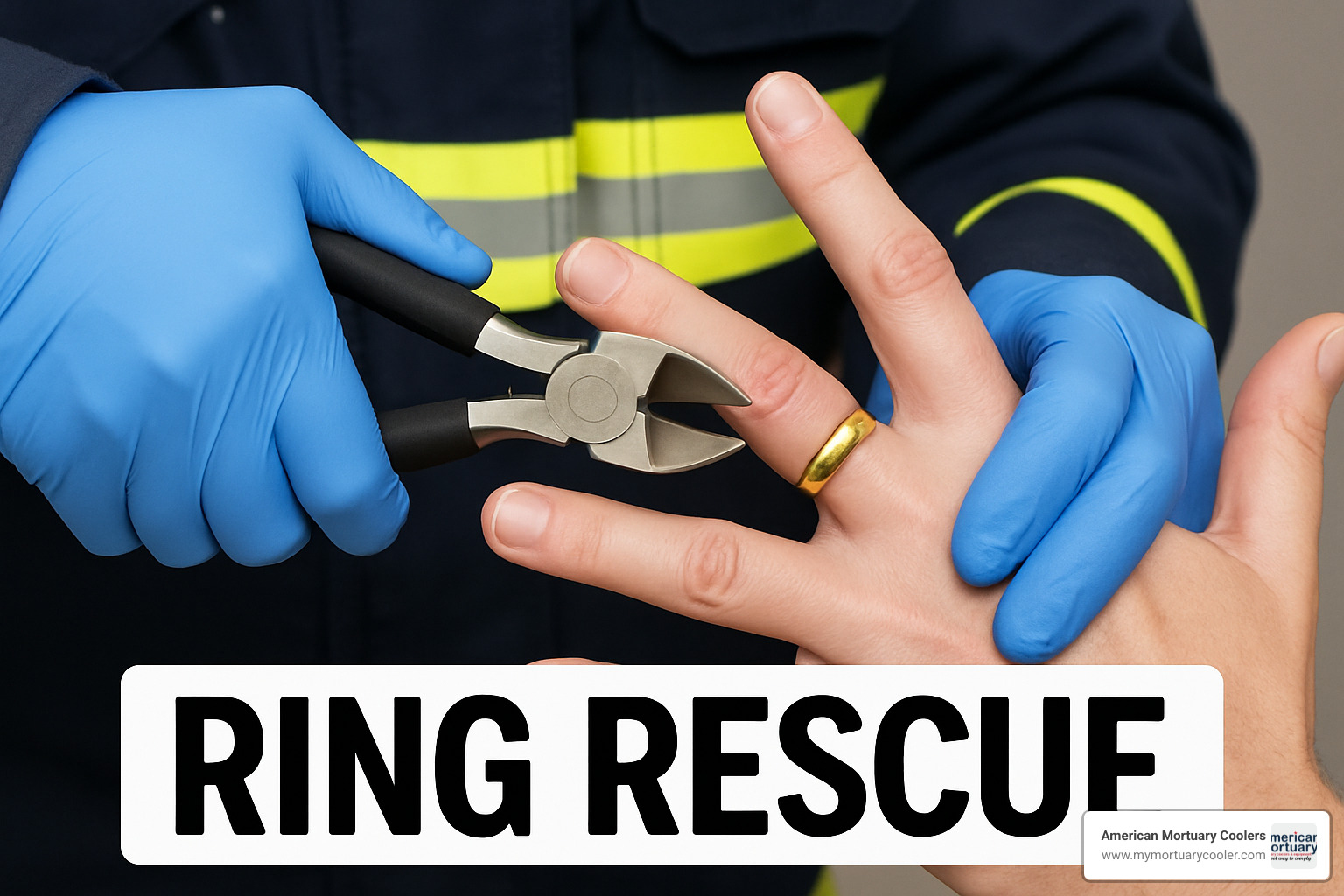
What makes the Ring Rescue approach better than old-school methods?
| Feature | Ring Rescue Kit | Traditional Methods |
|---|---|---|
| Finger Shrinkage | 100% of the time with Compression Device | Inconsistent with ice or wrapping |
| Heat Generation | Virtually none with Dolphin Cutter | High with Dremel tools (burn risk) |
| Metal Compatibility | Works on all metals including tungsten & titanium | Many tools can't cut hard metals |
| Preservation Rate | High chance of non-destructive removal | Often defaults to cutting |
While competitors like Zayden Medical and HexArmor offer similar products, the Ring Rescue Compression Device is FDA registered and designed by actual doctors and engineers who understood the problem firsthand.
Ring Rescue Compression Device Step-by-Step
Here's how the Compression Device works:
First, professionals assess your finger carefully, checking circulation. Then they place the compression cuff on your finger, making sure it doesn't touch the ring itself.
The device applies gentle, uniform pressure to compress your finger tissues. For rings stuck less than two weeks, one 5-minute round often does the trick. For longer-term situations, two or three 5-minute rounds might be needed.
During compression, they'll keep your hand lifted above heart level to help drain fluid away. When the time's up, your finger size will be temporarily reduced, creating that crucial window of opportunity to slip the ring off safely.
Ring Rescue Manipulation Techniques After Compression
Once your finger has been compressed, skilled manipulation makes all the difference:
They'll start by applying a special non-hydrating lubricant that won't soak into your skin or make swelling worse.
For most rings, the corkscrew glide technique works wonders. This involves twisting the ring in a spiral motion while gently pulling forward with consistent pressure.
For rings with stones or irregular shapes, the rocker method is preferred. This involves carefully rocking the ring back and forth over the knuckle while applying lubricant, gradually working it forward with each gentle motion.
Method 4: Professional Cutting—Electric & Manual Options
When compression fails and a ring must come off quickly, cutting becomes the necessary next step. Modern ring rescue technology has dramatically improved both safety and success rates.
The Dolphin Ring Cutter from the Ring Rescue Kit stands out as a game-changer in emergency departments and jewelry shops alike. Its SmartCUT Technology takes the guesswork out of cutting even the toughest metals. One person can safely operate it, and it cuts through everything from traditional gold bands to those supposedly "indestructible" tungsten and titanium rings.
Perhaps most importantly, it generates minimal heat during cutting, preventing the secondary burns that can occur with overheated Dremel tools.

Traditional Cutting Options
If you don't have access to a Dolphin Cutter, traditional methods still work—they just require more caution:
- Manual ring cutters require significant hand strength and often a second person to stabilize both the tool and the patient's hand.
- High-speed Dremel tools can slice through most metals effectively, but they generate heat. Continuous cooling with water or saline is essential to prevent burns.
- For tungsten rings specifically, bolt cutters sometimes work because tungsten, while incredibly hard, is surprisingly brittle.
Competitors like Zayden Medical offer their Z-Saw cutter, while HexArmor provides the RingCutter tool. General medical suppliers like Bound Tree and Henry Schein also carry various ring cutting solutions.
Best Practices for Cutting Hard Metals
Modern jewelry metals present unique challenges:
Tungsten Carbide Rings are nearly impossible to cut with traditional tools, but they can be cracked. The Dolphin Cutter handles them beautifully, but in its absence, applying pressure with vice grips sometimes works by exploiting tungsten's brittleness.
Titanium Rings require specialized cutting wheels or the Dolphin Cutter, and cooling is non-negotiable. The metal transfers heat to skin extremely efficiently, making burns a real concern.
Cobalt Rings share titanium's stubbornness but are often denser. Diamond-tipped cutting tools are a must, and you might need to make two cuts to fully remove the ring.
Regardless of the metal, always follow these safety essentials:
- Always use a finger guard between the cutting tool and skin
- Apply continuous cooling during cutting
- Take short breaks during cutting with traditional tools to let both the tool and the ring cool down
Latest case study on novel cutting device confirms what we've seen in the field—modern cutting technology saves both fingers and precious rings when used properly.
Method 5: Special Scenarios—Smart Rings, Arthritic Knuckles & Chronic Swell
Certain ring rescue situations require creative thinking and specialized approaches. Let's explore three particularly challenging scenarios.
Smart Rings with Electronics
The wearable technology boom has introduced a new complication: smart rings like Oura contain sensitive components that change the entire removal equation.
The biggest concern is the lithium-ion battery. Unlike traditional rings, cutting into a smart ring risks puncturing this battery, which could lead to chemical burns or even small fires.
Before attempting any removal, identify whether you're dealing with a smart ring. Most have a distinctive appearance with a flatter internal surface where sensors contact the skin.
Compression is your safest first option with smart rings. The Ring Rescue Compression Device shines here because it avoids any interaction with the electronics.
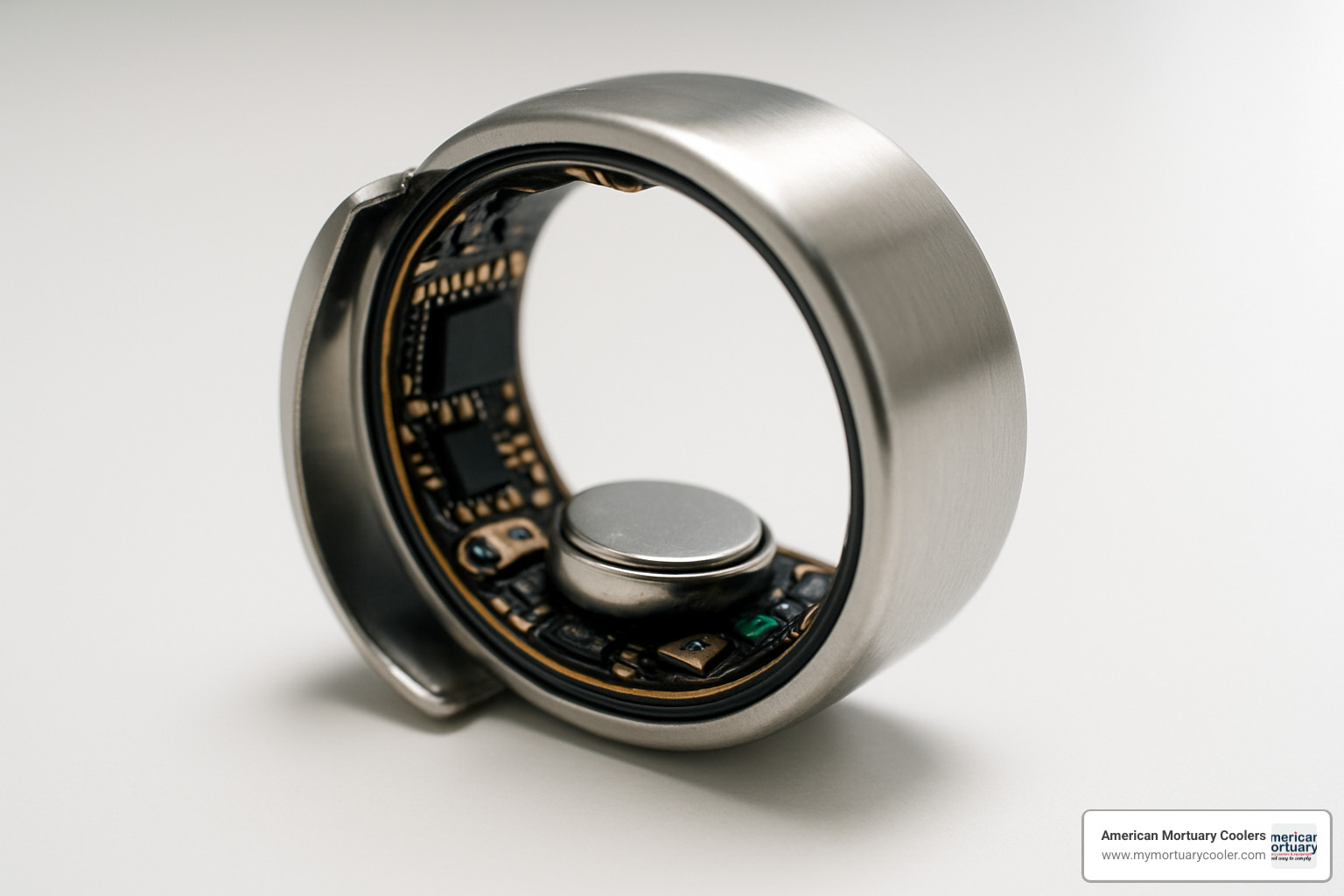
If cutting becomes absolutely necessary, contact the manufacturer first. Companies like Oura provide specific emergency removal guidance. Always wear appropriate gloves and eye protection in case of battery rupture.
Arthritic Knuckles and Long-Term Stuck Rings
Arthritic fingers present a unique challenge because we're dealing with structural bone changes rather than just fluid swelling.
Be realistic with expectations. Unlike soft tissue, bone structure cannot be compressed. If the knuckle has significant arthritic enlargement, you may ultimately need to cut the ring despite your best compression attempts.
For these chronic cases, try three full rounds of 5-minute compression (15 minutes total) to maximize tissue reduction. The longer the ring has been stuck, the more the soft tissue adapts to its presence, developing tissue fibrosis.
In medical settings, a digital nerve block can be incredibly helpful. Temporarily eliminating pain allows for more aggressive manipulation techniques that would otherwise be too uncomfortable.
Safe Removal of Battery-Powered Rings
When dealing specifically with smart rings containing batteries, safety becomes your primary concern.
Never use pointed tools that might pierce the battery compartment. Traditional ring cutters with their sharp cutting wheels can be particularly dangerous with smart rings.
Most manufacturers like Oura now provide emergency protocols for their products. These aren't just suggestions—they're carefully developed to prevent battery damage. Follow them precisely.
Many fire departments have recently developed expertise in removing electronic devices safely. If you're in a hospital or clinical setting dealing with a smart ring, don't hesitate to call in this specialized help.
Competitors like Zayden Medical and HexArmor are developing specialized tools for smart ring removal, but the technology is still evolving. For now, compression remains the safest approach for these high-tech accessories.
Frequently Asked Questions about Ring Removal
Does the Ring Rescue Compression Device work 100% of the time?
While the Ring Rescue Compression Device successfully shrinks finger size every time, that doesn't always guarantee the ring will slide off. Several factors influence success:
Recent versus chronic swelling makes a huge difference. When a ring has been stuck for just a few days, the swelling is mostly fluid that compresses easily. But rings stuck for months develop more permanent tissue changes that are less responsive to compression.
Bone structure is something we can't change with compression. Arthritis or naturally large knuckles may prevent even the best compression device from working non-destructively.
Proper technique after compression is absolutely crucial. The manipulation method after compression often determines success or failure. A properly lubricated, gently twisted ring has a much better chance than simply pulling straight.
What if compression fails—do I cut the ring immediately?
When that first compression attempt doesn't free the ring, don't rush to cut! There's a methodical approach that can save both fingers and cherished jewelry.
First, consider additional compression rounds. Many cases where the first round didn't quite do it succeed with a second or third 5-minute session.
Take a moment to reassess your technique. Are you using enough lubricant? Are you trying both the corkscrew and rocker methods?
Sometimes a short break between attempts allows for additional fluid drainage. Rings that wouldn't budge sometimes slide off after a 10-minute rest period with the hand lifted.
Of course, always prioritize circulation. If the finger is severely compromised, cutting becomes necessary regardless of the ring's sentimental value.
How do I prepare a patient with severe pain before removal?
Dealing with a painful stuck ring requires both physical and psychological preparation.
In medical settings, professionals have several options. A digital nerve block provides complete numbness and makes the process virtually painless. Topical anesthetics can help with surface pain, while mild sedation might be appropriate for extreme anxiety cases.
Outside medical settings, options are more limited but still helpful. Ice application provides natural numbing, though it's less effective than medical anesthetics. Over-the-counter pain relievers may help if medically appropriate for the person.
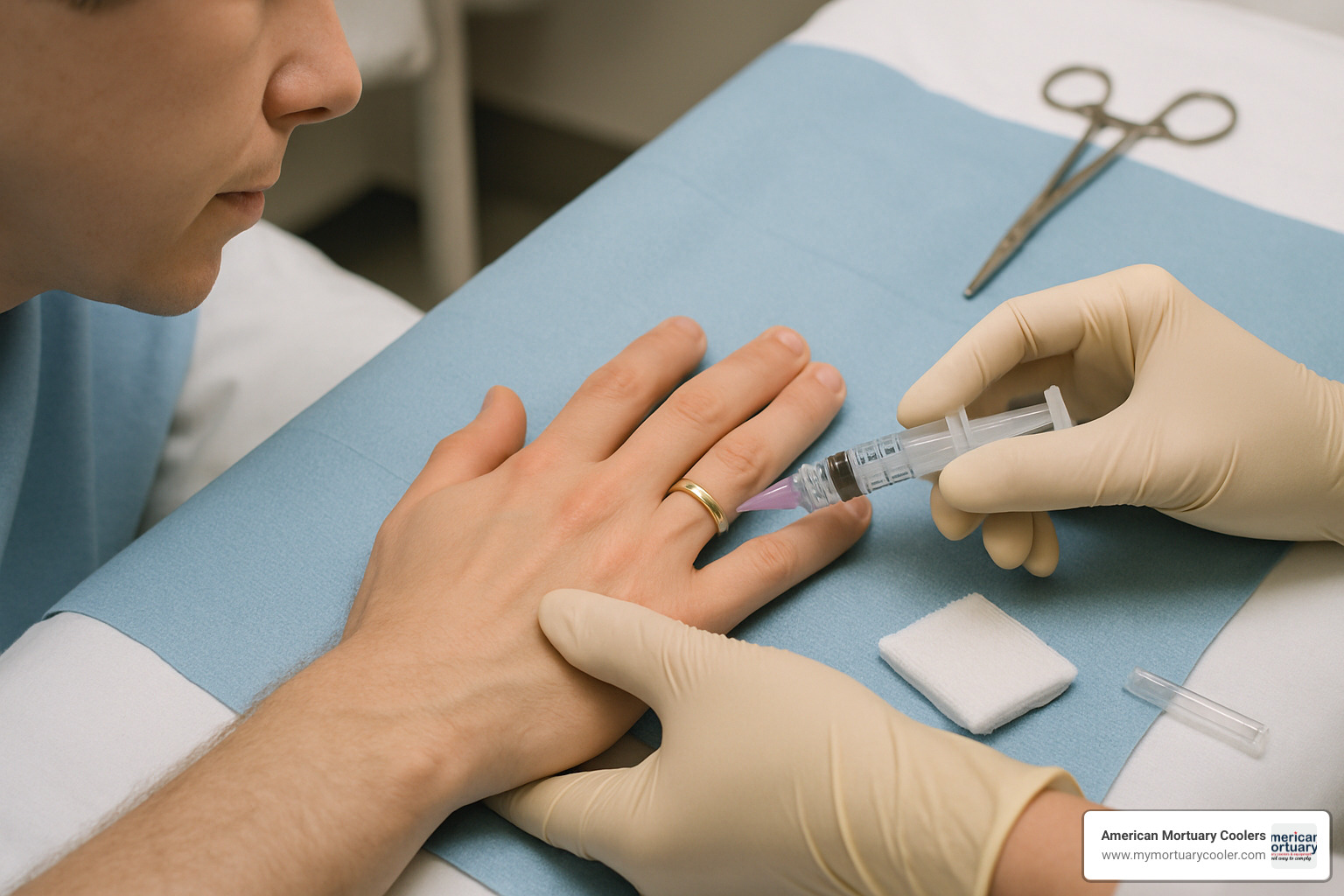
Never underestimate the power of psychological comfort. A clear, step-by-step explanation of what to expect can help anxious patients relax considerably. A calm, confident approach from the person performing the removal makes a world of difference.
Patient positioning matters tremendously too. A comfortable, supported position reduces muscle tension, while keeping the hand lifted improves both comfort and effectiveness by reducing blood flow to the finger.
Conclusion
When it comes to ring rescue, having the right tools and techniques makes all the difference between saving a cherished ring and having to cut it off—or worse, risking serious injury to the finger. At American Mortuary Coolers, we've seen how proper equipment can turn a potential emergency into a simple procedure.
The five methods we've explored offer a complete toolkit for handling stuck rings in any situation:
- Home first-aid with ice, elevation, and lubricant works for mild swelling
- Classic wrap techniques like dental floss or rubber bands provide more compression
- The Ring Rescue Kit offers professional-grade compression and cutting options
- Professional cutting tools safely remove rings when preservation isn't possible
- Specialized approaches for smart rings and arthritic fingers address unique challenges
Time matters in these situations. What starts as an uncomfortable tight ring can quickly become a medical emergency with the risk of tissue death if blood flow remains restricted too long.
While companies like Ring Rescue, Zayden Medical, and HexArmor offer specialized tools, American Mortuary Coolers provides comprehensive solutions for emergency services, medical facilities, and fire departments looking to upgrade their ring rescue capabilities.
Based in Tennessee with distribution across all 48 contiguous states, we're committed to providing reliable equipment to professionals who need dependable tools. While our name highlights our custom mortuary coolers, our expertise extends to a range of emergency and medical equipment designed to perform flawlessly when it matters most.
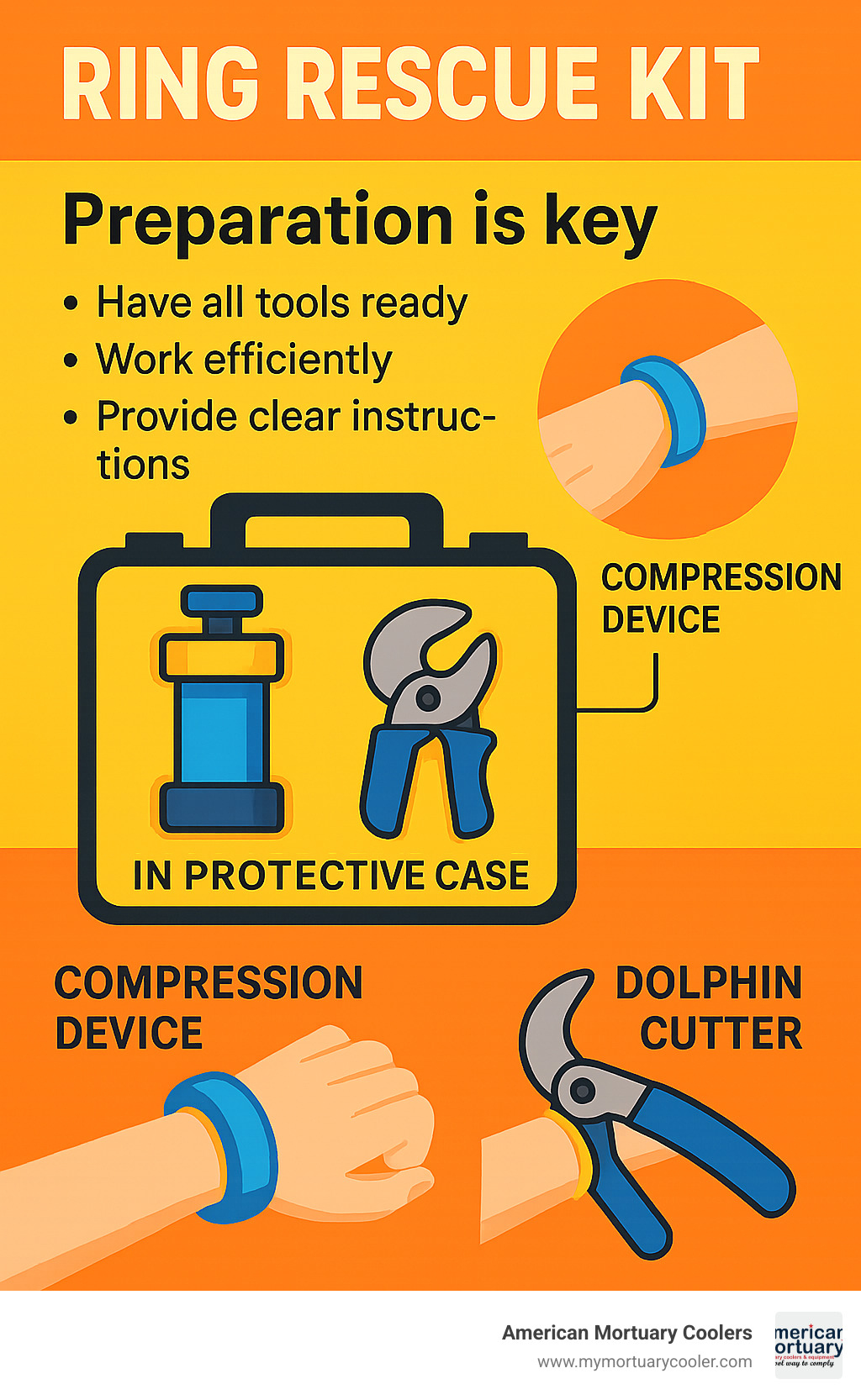
Remember: The goal of ring rescue is always to protect both the patient and their treasured jewelry. With the right approach and tools, you can achieve both in most situations—keeping fingers safe and sentimental rings intact.



